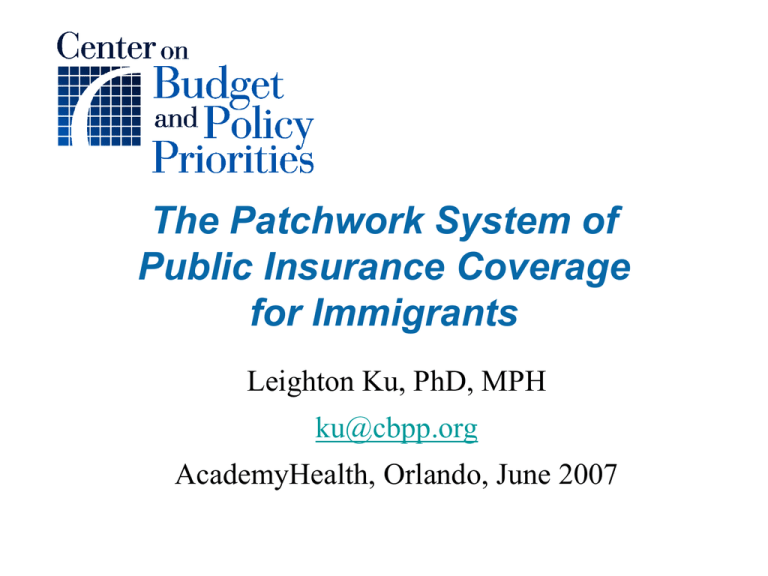The Patchwork System of Public Insurance Coverage for Immigrants Leighton Ku, PhD, MPH
advertisement

The Patchwork System of Public Insurance Coverage for Immigrants Leighton Ku, PhD, MPH ku@cbpp.org AcademyHealth, Orlando, June 2007 What Share of the Uninsured Are Immigrants? Naturalized Citizens 5% Native-born Citizens 74% Source: March 2006 CPS Non-citizen Immigrants 21% Immigrants & Uninsured Immigrants Are Mostly Working Age Adults 100% 12% 5% 0.1 mil 83% 8.3 mil. 12% 1.0 mil. Non-citizens Uninsured Noncitizens 80% 60% 60% 40% 20% 28% 0% Native-born Source: CPS, March 2006 Elderly Adults Children Almost Half of All Non-citizen Immigrants Are Uninsured Native-born Citizens Non-Citizen Immigrants 0% Uninsured 20% Medicaid/SCHIP 40% Other Public 60% 80% Employer-sponsored Source: March 2005 Current Population Survey 100% Other Private Public Programs Serve Small Fraction of Lowincome Immigrants (Below 200% Poverty) Native-born Citizens Non-Citizen Immigrants 0% Uninsured 20% Medicaid/SCHIP 40% Other Public 60% 80% Employer-sponsored Source: March 2005 Current Population Survey 100% Other Private Complex Medicaid/SCHIP Eligibility Rules • Medicaid usually not available for childless adults. • Citizens fully eligible, including naturalized and USborn citizen children. • Lawful permanent residents (LPRs) not fully eligible during 1st five years in US, but: – Refugees and asylees eligible for 1st seven years in US. Veterans, etc. eligible. – Many states use state funds to cover immigrants during 5 year bar in Medicaid or SCHIP. • Undocumented and other immigrants eligible for emergency Medicaid coverage, including child birth. Barriers to Participation • Participation low even among eligible immigrants (or citizen children of immigrants) • Lack of knowledge • Lack of language assistance during enrollment • Confusion and fear about rules • Medicaid citizenship documentation • Community outreach can help, but outreach funds have been limited in recent years. Immigrant Growth Among States, 1990-2005 NH VT WA ME ND MT MN OR ID SD WI MI RI WY PA IA NE NE NV CO CA KS WV VA NC AZ OK NM TN TX AK AL DC SC AR MS DE MD KY MO CT NJ OH IN IL UT MA NY GA LA FL HI Traditional High Migrant States (11 + DC) (above US avg in 1990) New Growth States (27) (# immigrants at least doubled 1990-2005) Substantial State Coverage of LPR Children, 2007 WA* ME* MN* NY* PA* NE NE* IL* CA* VA* MA* RI* CT * NJ* DE * MD* DC * TX * HI * 11 Traditional Migrant States *Coverage (10 + DC) No Coverage (1) FL* 27 New Growth States *Coverage (6) No Coverage (21) 12 Other States *Coverage (2) No Coverage (10) Source: Cox, forthcoming Kaiser Commission on Medicaid and the Uninsured report Substantial State Coverage of LPR Parents, 2007 WA* ME* MN* NE NE* CA* 11 Traditional Migrant States *Coverage (5 + DC) No Coverage (6) Source: Cox, forthcoming NY* PA* MA* CT * NJ* DE * DC * 27 New Growth States *Coverage (4) No Coverage (23) 12 Other States *Coverage (2) No Coverage (10) Source: Cox, forthcoming Kaiser Commission on Medicaid and the Uninsured report Medicare Eligibility • Non-citizens less likely to be elderly. Many immigrants return to home country when elderly. • LPRs and refugees eligible for Medicare, same as citizens. – If have less than 40 quarters of work, may buy into Part A. • Legally present “non-qualified” eligible if they had at least 40 quarters of authorized work. • Undocumented ineligible. Other Public Care • Sec. 1011 – to cover costs of uncompensated emergency care for uninsured, undocumented aliens. Underused. EMTALA requires basic emergency treatment for all. • Health centers – all immigrants eligible for free or subsidized care at federally-funded health centers. • Public & nonprofit hospitals & clinics often offer free or subsidized charity care, but sometimes eligibility for undocumented is limited due to state or local rules. Average Annual Medical Expenditures for NonElderly Adults by Type, Los Angeles County $3,500 $3,000 $2,500 $2,963 52% $2,340 $2,000 58% $1,760 $1,500 $1,000 46% 41% 28% $500 $0 $1,341 20% Native-born Citizen 20% 23% 23% 22% 30% 36% Naturalized Citizen Out of Pocket Legal Perm Resident Public Undocumented Private Source: Adapted from Goldman, Smith and Sood. Health Affairs 2006 Potential Federal Policies • Could include option to cover LPR children and pregnant women during SCHIP reauthorization. • Comprehensive immigration reform?? • May include a long pathway to earned legal status & citizenship and stronger immigration enforcement. Effect on public coverage modest and slow. • Legal status and reduced flow of immigrants may lead to better jobs and increased private coverage. • Binational insurance could reduce private insurance costs in border areas for legally present immigrants. Potential State Actions • Immigration volatile issue in many states. Usually not a visible issue in state health reforms. • Some expansions presented as “all kids” proposals, as in Illinois or California counties. • Mixed story in broader health coverage expansions. • Proposals to expand coverage by diverting DSH or UPL funds may impair safety net for immigrants. • State or local anti-immigrant laws could cause access problems for undocumented and other immigrants. But It’s Not Just Coverage… • Even when insured, immigrants have less access to care and receive poorer quality care due to language barriers. • Federal civil rights policies require free interpretation for LEP, but no funding stream and little enforcement. • HRET: Only 3% of hospitals get any reimbursement for interpretation, from Medicaid. • Potential for language reimbursement (Medicare, Medicaid, private insurance). Questions for the Future • What are costs of uncompensated care and of statefunded coverage for immigrants? • How can we improve enrollment among eligible immigrants or access among insured immigrants? • Quality of care for immigrants? More hospitalization for ambulatory-sensitive conditions? • How do immigrants’ health coverage, utilization and cost change over time? What are effects of changes in immigration status? • How can public perceptions of immigrants be improved?






